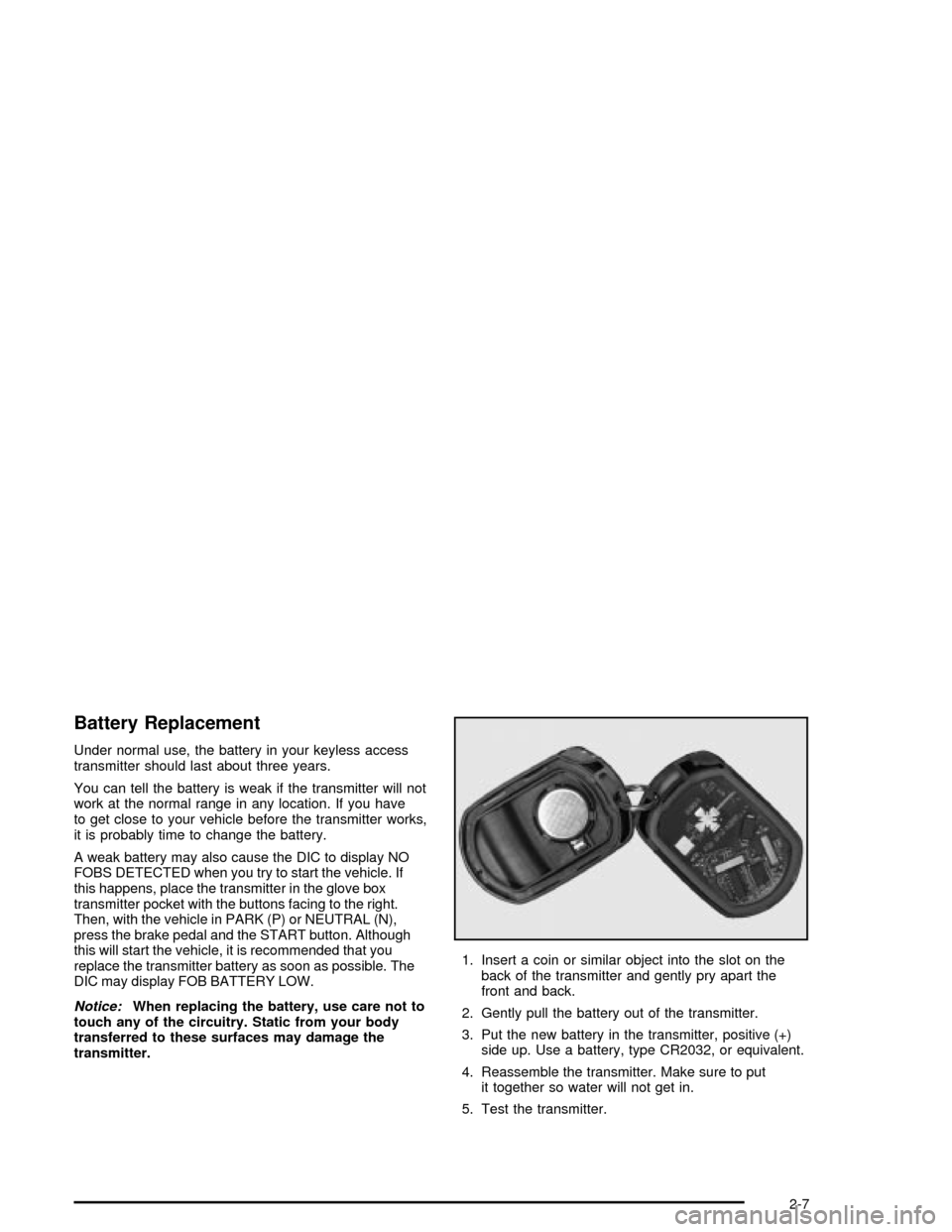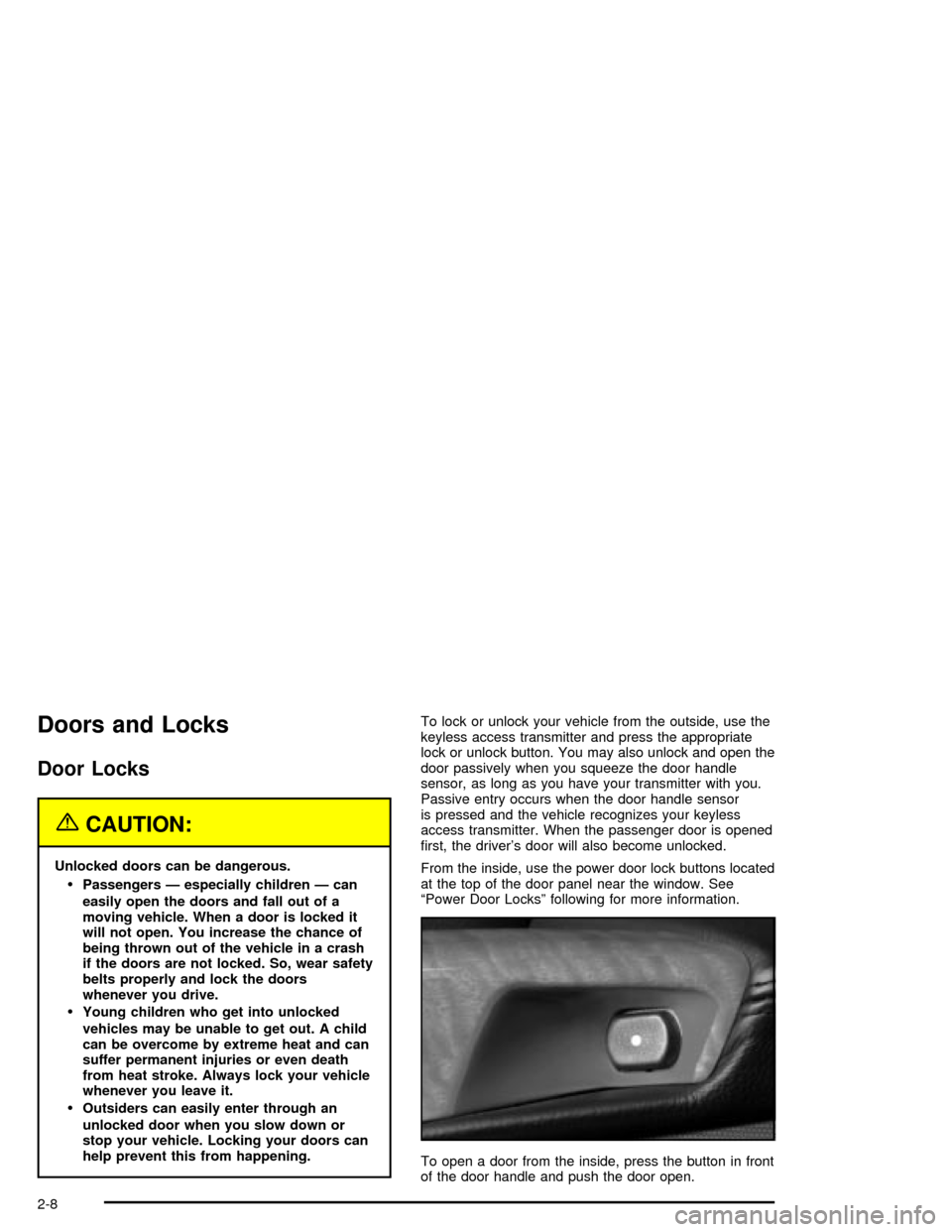buttons CADILLAC XLR 2004 1.G Owners Manual
[x] Cancel search | Manufacturer: CADILLAC, Model Year: 2004, Model line: XLR, Model: CADILLAC XLR 2004 1.GPages: 356, PDF Size: 2.36 MB
Page 9 of 356

Power Lumbar
The driver's and
passenger's seatback
lumbar support switches
are located on the
outboard sides of
the seats.
Use the power seat controls ®rst to get the proper
position, then continue with the lumbar adjustment.
Use the top lumbar switch to adjust support to the
middle seatback and the bottom lumbar switch to adjust
support to the lower seatback. Press the front of the
switch to increase support and the rear of the switch to
decrease support.
Keep in mind that as your seating position changes, as
it may during long trips, so should the position of
your lumbar support. Adjust the seat as needed.
Heated and Cooled Seats
The buttons for the heated and cooled seats are located
on the climate controls.
((Heated/Cooled Seat):Press this button to turn the
feature on. The button on the left controls the driver's
seat and the button on the right controls the passenger's
seat. Each press of the button will take you to a
different setting. The settings available in order are HI
HEAT, LO HEAT, OFF, HI COOL, LO COOL and
OFF. You will be able to feel the temperature change in
a few minutes.
The feature will automatically shut off when the vehicle
is turned off.
1-3
Page 61 of 356

K(Unlock):Press this button once to unlock the
driver's door. The light on the door will ¯ash twice. Press
the button twice within 10 seconds to unlock both
doors. If it is dark enough outside, your interior lamps
will come on.
Your memory settings may also be recalled when you
press the unlock button on the keyless access
transmitter. See ªMemoryº in the Index for more
information.
G(Trunk):Press this button to open the trunk
while the engine is turned off or the shifter is in
PARK (P).
Matching Transmitter(s) to Your
Vehicle
Each keyless access transmitter is coded to prevent
another transmitter from working with your vehicle. If a
transmitter is lost or stolen, a replacement can be
purchased through your dealer. Remember to bring any
remaining transmitters with you when you go to your
dealer. Once your dealer has coded the new transmitter,
the lost transmitter will not work with your vehicle.
Each vehicle can have a maximum of four transmitters
matched to it.To match a new transmitter to your vehicle when you
have a recognized transmitter, do the following:
1. The vehicle must be off.
2. Have the recognized and new, unrecognized
transmitters on your person.
3. Go to the rear of the vehicle and insert the vehicle
key into the key cylinder located on the lower rear
fascia on the driver's side. See
Trunk on
page 2-11for more information on the key cylinder.
4. Turn the key ®ve times within ®ve seconds.
The trunk will open.
5. The DIC will display READY FOR FOB #X, where
X can be 2, 3 or 4.
6. Place the new, unrecognized transmitter in the
glove box transmitter pocket with the buttons
facing to the right.
7. Once the transmitter is programmed, a beep will
sound. The DIC will display READY FOR #X,
where X can be 3 or 4, or MAX # FOBS LEARNED.
8. Press the OFF/ACCESSORY button.
2-5
Page 62 of 356

To match a new transmitter to your vehicle when you do
not have a recognized transmitter, do the following:
1. The vehicle must be off.
2. Place the new, unrecognized transmitter in the
glove box transmitter pocket with the buttons
facing to the right.
3. Go to the rear of the vehicle and insert the vehicle
key into the key cylinder located on the lower rear
fascia on the driver's side. See
Trunk on
page 2-11for more information on the key cylinder.
4. Turn the key ®ve times within ®ve seconds.
The trunk will open.
5. The DIC message will display OFF-ACC TO
LEARN.
6. Press the OFF/ACCESSORY button.
7. The DIC will read WAIT 10 MINUTES and will
count down to zero, one minute at a time.
8. The DIC will display OFF-ACC TO LEARN again.
9. Press the OFF/ACCESSORY button.10. The DIC will read WAIT 10 MINUTES and will
count down to zero, one minute at a time.
11. The DIC will display OFF-ACC TO LEARN again.
12. Press the OFF/ACCESSORY button.
13. The DIC will read WAIT 10 MINUTES and will
count down to zero, one minute at a time.
14. A beep will sound and the DIC will read READY
FOR FOB #1. At this time, all previously know
transmitters have been erased.
15. Once the transmitter is recognized and
programmed, a beep will sound and the DIC will
display READY FOR FOB #2.
If you have additional transmitters to program, take
transmitter 1 out of the transmitter pocket and place
transmitter 2 in the pocket. This can be done repeatedly
until up to four transmitters have be programmed.
The DIC will then display MAX # FOBS LEARNED and
will exit the programming mode.
When you are done programming transmitters, press
the OFF/ACCESSORY button.
2-6
Page 63 of 356

Battery Replacement
Under normal use, the battery in your keyless access
transmitter should last about three years.
You can tell the battery is weak if the transmitter will not
work at the normal range in any location. If you have
to get close to your vehicle before the transmitter works,
it is probably time to change the battery.
A weak battery may also cause the DIC to display NO
FOBS DETECTED when you try to start the vehicle. If
this happens, place the transmitter in the glove box
transmitter pocket with the buttons facing to the right.
Then, with the vehicle in PARK (P) or NEUTRAL (N),
press the brake pedal and the START button. Although
this will start the vehicle, it is recommended that you
replace the transmitter battery as soon as possible. The
DIC may display FOB BATTERY LOW.
Notice:When replacing the battery, use care not to
touch any of the circuitry. Static from your body
transferred to these surfaces may damage the
transmitter.1. Insert a coin or similar object into the slot on the
back of the transmitter and gently pry apart the
front and back.
2. Gently pull the battery out of the transmitter.
3. Put the new battery in the transmitter, positive (+)
side up. Use a battery, type CR2032, or equivalent.
4. Reassemble the transmitter. Make sure to put
it together so water will not get in.
5. Test the transmitter.
2-7
Page 64 of 356

Doors and Locks
Door Locks
{CAUTION:
Unlocked doors can be dangerous.
·Passengers Ð especially children Ð can
easily open the doors and fall out of a
moving vehicle. When a door is locked it
will not open. You increase the chance of
being thrown out of the vehicle in a crash
if the doors are not locked. So, wear safety
belts properly and lock the doors
whenever you drive.
·Young children who get into unlocked
vehicles may be unable to get out. A child
can be overcome by extreme heat and can
suffer permanent injuries or even death
from heat stroke. Always lock your vehicle
whenever you leave it.
·Outsiders can easily enter through an
unlocked door when you slow down or
stop your vehicle. Locking your doors can
help prevent this from happening.To lock or unlock your vehicle from the outside, use the
keyless access transmitter and press the appropriate
lock or unlock button. You may also unlock and open the
door passively when you squeeze the door handle
sensor, as long as you have your transmitter with you.
Passive entry occurs when the door handle sensor
is pressed and the vehicle recognizes your keyless
access transmitter. When the passenger door is opened
®rst, the driver's door will also become unlocked.
From the inside, use the power door lock buttons located
at the top of the door panel near the window. See
ªPower Door Locksº following for more information.
To open a door from the inside, press the button in front
of the door handle and push the door open.
2-8
Page 94 of 356

Keep the original transmitter for use in other vehicles as
well as for future HomeLinkžprogramming. It is also
recommended that upon the sale of the vehicle,
the programmed HomeLink
žbuttons should be erased
for security purposes. Refer to ªErasing HomeLinkž
Buttonsº or, for assistance, contact HomeLinkžon the
internet at: www.homelink.com or by calling
1-800-355-3515.
Be sure that people and objects are clear of the garage
door or gate operator you are programming. When
programming a garage door, it is advised to park outside
of the garage.
It is recommended that a new battery be installed in
your hand-held transmitter for quicker and more
accurate transmission of the radio frequency.
Your vehicle's engine should be turned off while
programming the transmitter. Follow these steps to
program up to three channels:
1. Press and hold down the two outside buttons,
releasing only when the indicator light begins to
¯ash, after 20 seconds. Do not hold down the
buttons for longer than 30 seconds and do not
repeat this step to program a second and/or third
transmitter to the remaining two HomeLink
žbuttons.
2. Position the end of your hand-held transmitter about
1 to 3 inches (3 to 8 cm) away from the HomeLink
ž
buttons while keeping the indicator light in view.3. Simultaneously press and hold both the desired
button on HomeLink
žand the hand-held transmitter
button. Do not release the buttons until Step 4
has been completed.
Some entry gates and garage door openers may
require you to substitute Step 3 with the procedure
noted in ªGate Operator and Canadian
Programmingº later in this section.
4. The indicator light will ¯ash slowly at ®rst and then
rapidly after HomeLink
žsuccessfully receives the
frequency signal from the hand-held transmitter.
Release both buttons.
5. Press and hold the newly-trained HomeLink
žbutton
and observe the indicator light.
If the indicator light stays on constantly,
programming is complete and your device should
activate when the HomeLink
žbutton is pressed and
released.
To program the remaining two HomeLink
žbuttons,
begin with Step 2 under ªProgramming HomeLinkž.º
Do not repeat Step 1 as this will erase all of the
programmed channels.
If the indicator light blinks rapidly for two seconds
and then turns to a constant light, continue with
Steps 6 through 8 following to complete the
programming of a rolling-code equipped device
(most commonly, a garage door opener).
2-38
Page 95 of 356

6. Locate in the garage, the garage door opener
receiver (motor-head unit). Locate the ªLearnº
or ªSmartº button. This can usually be found where
the hanging antenna wire is attached to the
motor-head unit.
7. Firmly press and release the ªLearnº or ªSmartº
button. The name and color of the button may
vary by manufacturer.
You will have 30 seconds to start Step 8.
8. Return to the vehicle. Firmly press and hold the
programmed HomeLink
žbutton for two seconds,
then release. Repeat the press/hold/release
sequence a second time, and depending on the
brand of the garage door opener (or other rolling
code device), repeat this sequence a third time
to complete the programming.
HomeLink
žshould now activate your rolling-code
equipped device.
To program the remaining two HomeLink
žbuttons,
begin with Step 2 of ªProgramming HomeLinkž.º Do not
repeat Step 1.
Gate Operator and Canadian
Programming
Canadian radio-frequency laws require transmitter
signals to ªtime outº or quit after several seconds of
transmission. This may not be long enough for
HomeLink
žto pick up the signal during programming.
Similarly, some U.S. gate operators are manufactured to
ªtime outº in the same manner.
If you live in Canada, or you are having difficulty
programming a gate operator by using the
ªProgramming HomeLink
žº procedures (regardless of
where you live), replace Step 3 under ªProgramming
HomeLink
žº with the following:
Continue to press and hold the HomeLink
žbutton while
you press and release every two seconds (cycle)
your hand-held transmitter until the frequency signal has
been successfully accepted by HomeLink
ž. The
indicator light will ¯ash slowly at ®rst and then rapidly.
Proceed with Step 4 under ªProgramming HomeLink
žº
to complete.
2-39
Page 96 of 356

Using HomeLinkž
Press and hold the appropriate HomeLinkžbutton for at
least half of a second. The indicator light will come
on while the signal is being transmitted.
Erasing HomeLinkžButtons
To erase programming from the three buttons do the
following:
1. Press and hold down the two outside buttons until
the indicator light begins to ¯ash, after 20 seconds.
2. Release both buttons. Do not hold for longer than
30 seconds.
HomeLink
žis now in the train (learning) mode and can
be programmed at any time beginning with Step 2
under ªProgramming HomeLink
ž.º
Individual buttons can not be erased, but they can be
reprogrammed. See ªReprogramming a Single
HomeLink
žButtonº next.
Reprogramming a Single HomeLinkž
Button
To program a device to HomeLinkžusing a HomeLinkž
button previously trained, follow these steps:
1. Press and hold the desired HomeLink
žbutton. Do
not release the button.
2. The indicator light will begin to ¯ash after
20 seconds. While still holding the HomeLink
ž
button, proceed with Step 2 under ªProgramming
HomeLinkž.º
Resetting Defaults
To reset HomeLinkžto default settings do the following:
1. Hold down the two outside buttons for about
20 seconds until the indicator light begins to ¯ash.
2. Continue to hold both buttons until the HomeLink
ž
indicator light turns off.
3. Release both buttons.
For questions or comments, contact HomeLink
žat
1-800-355-3515, or on the internet at
www.homelink.com.
2-40
Page 110 of 356

Use the following steps to program each button:
1. Adjust the driver's seat including the seatback
recliner, lumbar and head restraint, both outside
mirrors and the steering wheel to a comfortable
position.
2. Press and hold button 1 until two beeps are heard,
then release the button.
A second mirror, seating and steering wheel position
can be programmed by repeating the above steps and
pressing button 2 (for driver 2). Each time a memory
button is pressed and released, a single beep will sound.
Each time button 1 or 2 is pressed and released while
the vehicle is in PARK (P), the memory positions will be
recalled after a brief delay. If the vehicle is not in
PARK (P), the memory buttons must be pressed and
held to recall the stored positions.
When the engine is started, the seat, mirrors, and
steering wheel may automatically adjust to their
programmed positions.To stop recall movement of the memory feature at any
time, press one of the power seat controls, power
mirror control buttons, memory buttons, or power
steering column control.
Two personalized exit positions can be set by ®rst
recalling the driving position (by pressing 1 or 2), then
positioning the steering wheel and seat in the desired
exit positions and then pressing and holding the
exit button until two beeps are heard. With the vehicle in
PARK (P), the exit position for the previously set
driver can be recalled by pressing the EXIT button.
When you use the keyless access transmitter to unlock
you vehicle, automatic seat and steering wheel
movement to the exit position may occur. The numbers
on the back of the transmitter, 1 and 2, corresponds
to the numbers on the memory buttons.
Further programming for automatic seat and mirror
movement can be done using the Driver Information
Center (DIC).
For programming information, see
DIC Vehicle
Personalization on page 3-66.
2-54
Page 165 of 356

You can use the Driver Information Center (DIC) to
display more detailed fuel information. While scrolling
through the DIC, you will also ®nd:
·AVERAGE XX.X MPG (Average Miles Per
Gallon):The fuel economy calculated for the last
20 gallons (76 L) of fuel used, or since you last
reset the display.
·INST XX.X MPG (Instantaneous Miles Per
Gallon):The fuel economy calculated for your
current driving conditions.
·RANGE XXX MI:The approximate distance you
can drive before refueling.
See
DIC Controls and Displays on page 3-55for more
information.
You should reset the fuel information display every time
you refuel. To reset AVERAGE, use the information up or
down button to scroll to AVE FUEL ECON and hold the
reset button. RANGE will automatically reset.
Driver Information Center (DIC)
This display gives you the status of many of your
vehicle's systems. The DIC is also used to display driver
personalization features and warning/status messages.
All messages will appear in the DIC display, located
at the bottom of the instrument panel cluster.
DIC Controls and Displays
The Driver Information
Center (DIC) buttons are
located to the right of
the steering wheel on the
instrument panel, near
the air outlets.
«4ª(Information):Press the top or bottom of this
button to scroll through the available features which
include the odometer, trip odometers, fuel range, miles
per gallon, average speed, timer, tire pressure and
remaining oil life.
+(Interior Lamps):Press this button to turn the
interior lamps on and off.
OPTION:Press this button to choose personal options
that are available on your vehicle.
3-55